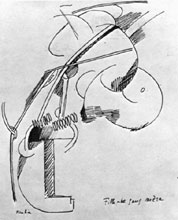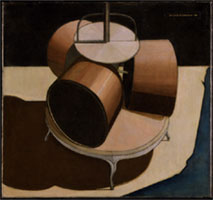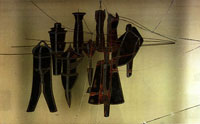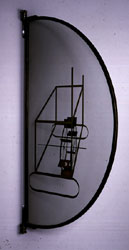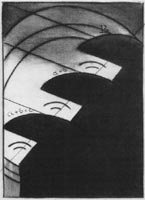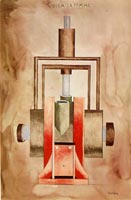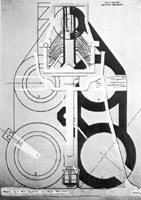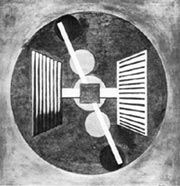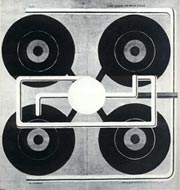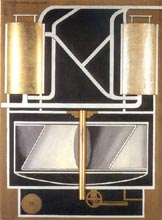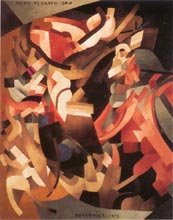Between Music and the Machine: Francis Picabia and the End of Abstraction by
Roger I. Rothman |
||||||||||||||||||||||||||||||||||||||||||||
|
Painting the Machine Picabia was called up for service soon after the war broke out in August. With the aid of Buffet's connections, he was able to find a relatively secure post as a general's chauffeur. Soon thereafter Picabia's father, on the staff of the Cuban embassy, arranged to have his son assigned to the task of negotiating shipments of sugar from Cuba to France. On their way to meet this mission, Picabia and his wife stopped off in New York. They arrived in June of 1915 and managed to postpone the trip to Cuba until some time in the late fall. In the meantime, Picabia resumed contact with de Zayas, Haviland and others around Stieglitz and his gallery. Almost immediately, he began collaborating on the group's newest project, the magazine 291, a large-format magazine, aggressively avant-gardist in design, far more experimental than that of Stieglitz's rather sober Camera Work.
One of the first of Picabia's contributions to 291 was a small ink drawing (hand-tinted in the deluxe edition) entitled Daughter Born without a Mother (Fille née sans mère) (Fig. 24). With its schematic depiction of a coiled spring alongside a collection of floral forms, the drawing recalls I See Again in Memory my Dear Udnie, a work he had probably "seen again" in New York for the first time since de Zayas took it with him in September the year before. (54) In its more clearly mechanical appearance, the drawing also suggests that his renewed contact with Duchamp (who arrived in New York around the same time) may have encouraged Picabia to harden his earlier organo-mechanic hybrid into something more obviously machine-like. In Duchamp's studio, Picabia must have seen not only Duchamp's Chocolate Grinder (Fig. 25), but also the two glass works, the 9 Malic Moulds (Fig. 26) and the semicircular Glider (Fig. 27), as well as the newly purchased glass plates that were to be used for the construction of The Large Glass. He must also have seen at least a few of Duchamp's readymades (the recent coinage of the term probably made the works all the more enticing). In other words, Picabia must have confronted, in one small space, almost the entire range of Duchamp's new, unequivocal rejection of modernist painting.
Although the machines Picabia used were more emphatically modern than Duchamp's Chocolate Grinder, his commitment to a similarly dry technique, drawn from the example of mechanical drawing, points toward a practice almost entirely at odds with well-worked brushstrokes and rich color combinations of his earlier abstractions. Perhaps the best example of this more modernized chocolate grinder is Picabia's Voilà la Femme (Fig. 29), a small watercolor of what appears to be a fragment of a piston. With its suggestion of a mechanically repeated back-and-forth motion, the image operates within the very same kind of sexual metaphorics that Duchamp was to make so central to his Large Glass. (56) In other words, early in 1915, Picabia seemed poised to follow Duchamp in breaking altogether with the practice of painting (and all its attendant values and promises). An observer of Picabia's labors in the Modern Gallery, the offices of 291, might well have imagined that the painter had given up all the concerns that guided him up to that point. And yet almost
immediately after preparing the mechanical portraits for 291,
Picabia began to paint again, working with oil, gouache, and, in some
cases metallic paint, on board. Over the course of the summer and fall
of 1915, Picabia painted six works of almost equal size, each measuring
around three to four feet on either side. (57)
A Little Solitude in the Middle of Suns (Petite
solitude au milieu des soleils)(Fig. 30),
Reverence (Révérence) (Fig.
31), Paroxysm of Sorrow (Paroxysme
de la douleur) [fig. 18], Machine
without a Name (Machine san nom) [fig.
19], This Thing is Made to Perpetuate My Memory (Cette chose est faite pour perpétuer mon souvenir) (Fig.
32), and Very Rare Painting on Earth (Très
rare tableau sur la terre) (Fig. 33)
were shown together in February of 1916 along with 10 other works, including
a number of smaller watercolors and drawings from the same period, (such
as Voilà Elle and This Machine Laughingly
Castigates Manners) as well as three abstract paintings from 1913-14
(Catch-as-Catch-Can (Fig. 34); Comic
Force; Horrible Sorrow).
Despite the immediate question posed by the fact that these six mechanomorphs were shown alongside three abstract paintings from the year before, scholars have been all but unanimous in their depiction of 1915 as the year in which Picabia made an absolute break with his previous concerns. (58) Implicit here is the consideration of Picabia as having followed a course parallel to that of Duchamp. (59) The explanation for this shift, when it is offered, typically turns on the outbreak of the war, (60) the confrontation with New York City's technological marvels, (61) the appeal to the idea that Picabia was a man with a "compulsive need for change." (62) And yet a number of things suggest that something more complex is at work here. For one, there is Buffet's insistence that Picabia, "was never able to suppress his pictorial vision. He remained a painter even in his most aggressive works." (63) Buffet's observation is all the more relevant here in that she used it to distinguish her husband's work from that of Duchamp for whom the abandonment of painting was a necessary logical step in his aesthetic of "destruction," as she put it. Indeed, it is somewhat surprising that Buffet has been the only one to make note of this most obvious distinction between these two artists--artists who have been called "Dada's Castor and Pollux, its yin and yang." (64) Buffet's understanding of her husband deserves attention, not only because it enables an entry into the possibility of distinguishing between Picabia's work and that of Duchamp, but also, and more importantly, because it provides the first indication of the ways in which the works from 1915 draw much of their conviction from the particularities of their dialog with that which seems, on the surface, to have been so definitively abandoned. Her observation points toward a more complex understanding of the ways in which the mechanomorphs draw from and respond to the ambitions, promises--and failures--of abstract painting. >>Next Notes
Figs.
25-27
|
||||||||||||||||||||||||||||||||||||||||||||
|
||||||||||||||||||||||||||||||||||||||||||||
